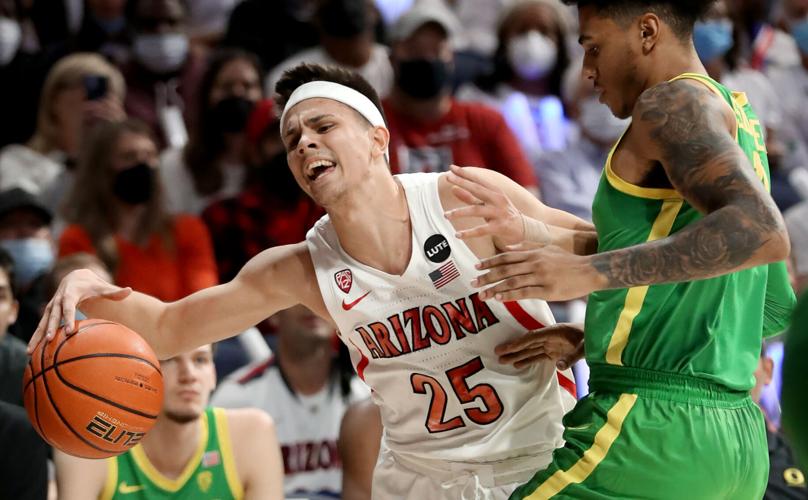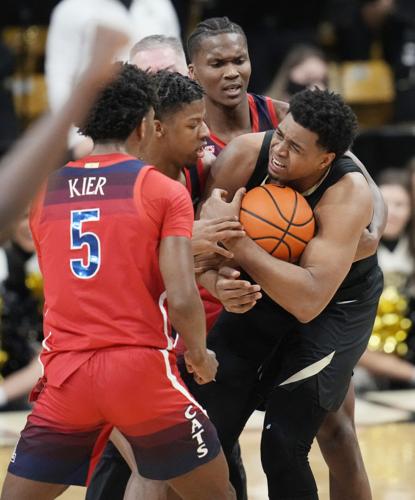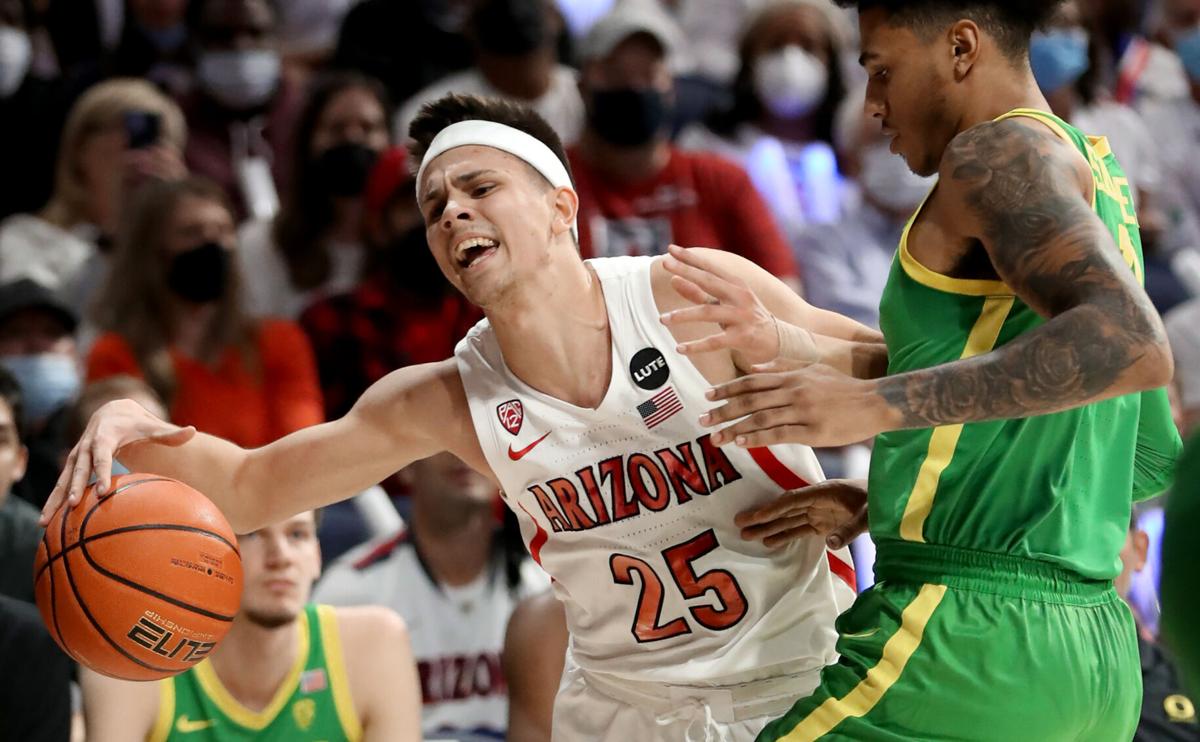Don MacLean has yet to sit down and analyze Arizona’s draw in the South region of the NCAA Tournament — not because the Pac-12’s all-time leading scorer is too busy with his broadcasting duties for the Pac-12 Networks and calling NBA games for Fox Sports.
MacLean hasn’t analyzed the Wildcats’ draw because, in his mind, it doesn’t matter.
“Arizona has arguably the biggest margin for error in the country, meaning they can withstand setbacks,’’ MacLean told the Hotline.
“We saw a perfect example of that in the Pac-12 Tournament. Their most important player (point guard Kerr Kriisa) got hurt in the first game, and they still won it.
“Arizona checks almost every box, if not every box. I don’t care who’s in their draw.”
MacLean isn’t alone in his unabashedly bullish assessment. The Wildcats are the No. 2 overall seed in the tournament behind Gonzaga, as well as the No. 2 betting favorite.
Following Selection Sunday, the Zags were installed as the +350 tournament favorite — a $100 bet would return $350 if they win the title — followed by Arizona (+600), Kentucky (+800) and Kansas (+900).
The analytics website FiveThirtyEight.com used statistical modeling to assess the tournament field and gave Arizona a 31.5% chance to reach the Final Four.
ESPN analyst Jay Bilas picked the Wildcats for the Final Four.
CBS analyst Clark Kellogg picked them to reach the title game before losing to Gonzaga.
Like the Zags, Arizona has elite perimeter play and the frontcourt size few teams can match. It has a projected lottery pick in wing Bennedict Mathurin and a slew of interchangeable parts that allow the Wildcats to function effectively at any tempo, against any style — fast or slow, big or small, zone or man.
All in all, they are better equipped than any recent team to end the Pac-12’s quarter-century national championship drought. (The last team to win it: Arizona in 1997.)
“You can have a really good discussion about the ways to beat them, kind of like people do in the NBA playoffs when it’s a seven-game series,” Pac-12 Networks analyst and former Arizona guard Matt Muehlebach said.
“But in a one-game elimination in the NCAA pressure cooker, it could be as simple as a bad shooting game — or a good shooting game by your opponent.
“The margin is so much less in a one-game scenario. I like to tell people it’s like you’re walking down the sidewalk. If it’s a six-inch drop to the street, you aren’t worried. But if it’s a 100-foot drop, then that feeling when you’re walking is entirely different.”
Which teams could derail Arizona’s pursuit of its first Final Four berth since 2001?
What issues could leave the Wildcats vulnerable in a South region that includes Big East champion Villanova, SEC winner Tennessee, Big Ten power Illinois and American champion Houston, which reached the Final Four last year?
Five challenges come to mind:

Colorado got physical with the Cats in Boulder, and outscored UA by 21 points in the second half in the Feb. 26 game.
1. Tempo trouble
Although the Wildcats have handled teams that slow the pace and work the shot clock, it’s not their preferred style. They are best when on the move, pushing the ball after missed shots and made baskets alike.
According to the Pomeroy advanced metrics, Arizona is No. 8 nationally in adjusted tempo. Of the title contenders, only Gonzaga plays faster.
“If you shorten the game, take away possessions, your odds as an underdog improve slightly,” Muehlebach said. “It’s just math. And there are teams that do that in their bracket.”
Villanova, the No. 2 seed, is 345th nationally in adjusted tempo (out of the 358 teams in Division I).
Houston, the No. 5 seed and a potential Sweet 16 opponent, plays slower than all but five teams in the NCAA field.
Both of the possible second-round foes, TCU and Seton Hall, are more comfortable jogging than sprinting.
2. Kriisa’s ankle
Point guard Kerr Kriisa sprained his right ankle in the quarterfinals of the Pac-12 tournament against Stanford. Although he’s expected to play in the NCAAs — perhaps as early as the second round — his effectiveness is uncertain.
Kriisa is not a high-level defender; if he’s on the court, teams with quality point guards will attack. Also, his shot selection has, at times, been suboptimal.
But his emotional presence and floor leadership are vital to a prolonged march through the madness.
“He just plays so fast,” Muehlebach said. “When he’s in the game, the ball moves. He’s their engine.”
3. Traffic jams
Several Pac-12 opponents opted to pack the lane against the Wildcats, limiting their ability to penetrate and use big men Christian Koloko, Azuolas Tubelis and Oumar Ballo in pick-and-roll situations.
The tactic was intended to force the Wildcats to rely on their 3-point shooting, which is solid but not elite.
“The thing that kept teams in it, like Colorado and Stanford, is they tried to switch (every position defensively) to eliminate the dunks and layups,” MacLean said.
“Arizona didn’t get the pick-and-rolls to the basket in the half-court offense. So what did they do? They started to throw over the top in transition and semi-transition. They have a counter for everything you try to do.”
4. Rock fights
Envision this scenario: It’s the second round against Seton Hall, or the Sweet 16 against Houston or Illinois, and the final 10 minutes become a grind.
The tempo slows. Bodies fly. Every shot, pass and step is contested. And the officials allow more grabbing and pushing than Arizona experiences in the Pac-12. It’s exactly the rock fight the underdog wanted.
Will Arizona have enough gumption, enough toughness, to survive?
Over the years, plenty of Pac-12 teams have been eliminated from the NCAAs because they weren’t physically or mentally tough enough.
“The first thing coaches talk about is how physical Arizona is,” MacLean said. “You don’t see it that much because the Pac-12 isn’t a physical conference. But they are a physical team.
“The championship game was physical, UCLA’s a very physical team, and Arizona still won. I’m not sure that would be a problem for them.”
5. Passivity problems
Arizona’s most glaring weakness — its only weakness, some would say — is the lack of NCAA Tournament experience. Tommy Lloyd is a first-year head coach and only one player, Ballo, the reserve big man, has participated in March Madness.
For four months, the Wildcats have played without the burden of being the favorite. Nobody expected to roll through the Pac-12 and earn a No. 1 seed.
This week, they become the hunted on terrain that can liquefy at any moment.
“One of the things that gets overlooked is the mental makeup of the team,” said Muehlebach, a member of Arizona’s 1988 Final Four team. “They play fearless and have fun.
“But it’s tough in the NCAAs as a high seed because of the expectations. You want so badly to get to the Final Four, and when you want something that bad, it can be a hurdle.
“You can have incredible scoring balance, you can have tremendous focus and attention to detail. But the one thing you cannot do is, you can’t play not to lose. You have to play to win. I love how Tommy Lloyd says, ‘We haven’t accomplished anything’ and how he always says they have to attack.
“That’s the key to the whole thing. They have to attack.”






